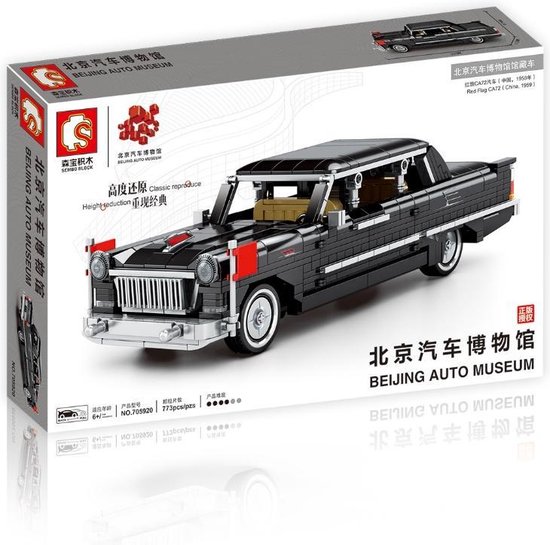Sembo 705920 – Hongqi CA72 Limousine – 773 onderdelen – Lego Compatibel – Bouwdoos
Sembo 705920 – Hongqi CA72 Limousine
Uit de Beijing Auto Museum serie komt deze luxe auto uit China.
The Hongqi CA72 was developed by First Automotive Works (FAW) based in Changchun, which was founded in 1953 with technical and financial support from the Soviet Union. FAW originally primarily produced commercial vehicles, in particular heavy trucks based on Soviet models under the Jiefang brand. In 1958, the Great Leap Forward began in China, aimed at eliminating China’s industrial gap to the western industrialized countries. The effects of this initiative were also felt in the automotive sector.[1] From 1958, several Chinese plants began constructing passenger cars for civilian use: however, because China did not have a homegrown auto industry, most of the new automotive development was based on Western models, imported in small numbers: while outright copying was prohibited, most of the vehicles in this period differed far more from Western vehicles in looks than technology, where foreign platforms were often taken and completely duplicated. One of the first cars was the FAW-developed middle-class sedan Dongfeng CA71, which was basically a replica of the French Simca Vedette with a Mercedes-Benz 6 cylinder engine. During this time, FAW also began to develop representative vehicles for the top politicians. The initiative for this was said to have come from the party leader Mao Zedong himself, who had expressed the wish in 1955, at the CPC congress, to replace Soviet limousines[2] driving in with a car from national production.[3][4]
In August 1958, the first prototype of a saloon was completed. FAW gave the car the model name Hongqi, referring to the revolutionary symbol of the Red Flag. Due to the short timeframe given by the government aiming for a 1959 production deadline, this was actually not a fully FAW built prototype, but a reskinned Chrysler Imperial, having gotten access to an imported 1955 example in Jilin, FAW’s hometown. [5]
The first prototype in the dimensions and in the basic technical structures already corresponded to the later production model. In the body area, however, there were significant differences. The prototype had a wide chrome strip on the sides of the car. Above the rear wheels was a large air intake, the edge of which was also chrome plated. The fan-shaped grille was very narrow at the bottom and opened far up.[6] These elements accounted for the production version. In automotive literature, the prototype is described as unattractive and coarse.[7] In the following six months, six other prototypes were created, including two four-door convertibles, all of which differed in details from each other and from the later production version.[1]
A 1959 Hongqi CA72 in Shanghai Automobile Museum
Hongqi CA72 rear
Hongqi CA72 Convertible
In 1959, FAW finally began mass production of the now called Hongqi CA72 sedan, which lasted until 1965 or 1967 depending on the source. Until 1962, the CA72 competed with the Beijing Automobile Works produced sedan Beijing CB4, which looked more modern (although also based on an American full-size sedan – the CB4 was modeled after the 1950s Buick Special), but ultimately could not prevail. Unlike the CB4, the Hongqi CA72 has been technically improved over the years in details. This affected, among other things, the brakes, which were too weak in the first vehicles. From 1965, the Hongqi was referred to as CA770. Externally and technically, the CA




